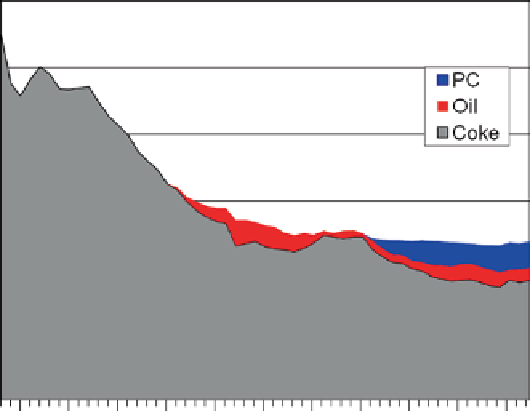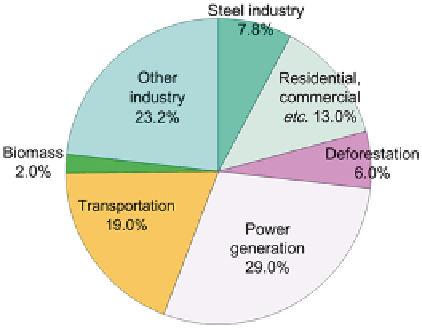Environmental Engineering Reference
In-Depth Information
Fig. 12.13
CO
2
emission
from different sectors in the
world (Global emissions in
2011: 33.5 million t)
㻝㻘㻞㻜
㻜
㻝㻘㻜㻜
㻜
㻤㻜㻜
NJW+0
㻢㻜㻜
㻠㻜㻜
㻞㻜㻜
㻝㻥㻡㻜㻝㻥㻡㻡㻝㻥㻢㻜㻝㻥㻢㻡 㻝㻥㻣㻜㻝㻥㻣㻡 㻝㻥㻤㻜㻝㻥㻤㻡 㻝㻥㻥㻜㻝㻥㻥㻡㻞㻜㻜㻜
Fig. 12.14
Changes in the reduction reagent rate of the blast furnace ironmaking process
reduced to about 475 kg/ton-steel due to efficient improvements (Fig.
12.14
). How-
ever, such a value is already close to the theoretically ideal condition when one con-
siders the energies necessary for the reduction of iron oxides, and for heating metal
and slag. Therefore a drastic innovation of the process itself is urgently required.
In order to further reduce CO
2
emissions from the iron & steelmaking process, it
is necessary to employ fuel substitution to hydrocarbon gases like natural gas, which
generates less CO
2
, and/or biomass, which is currently classed as a carbon-neutral
fuel. European Union nations started the ULCOS (Ultra-Low CO
2
Steelmaking)
project in 2004, which aims to develop a new iron and steelmaking technology
to reduce CO
2
emissions by more than 50 % from the present value. It completed


